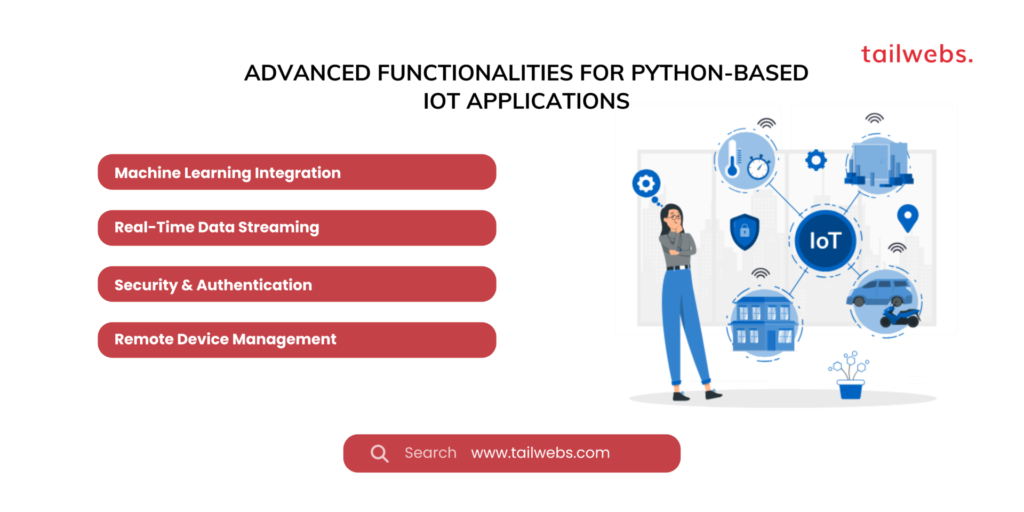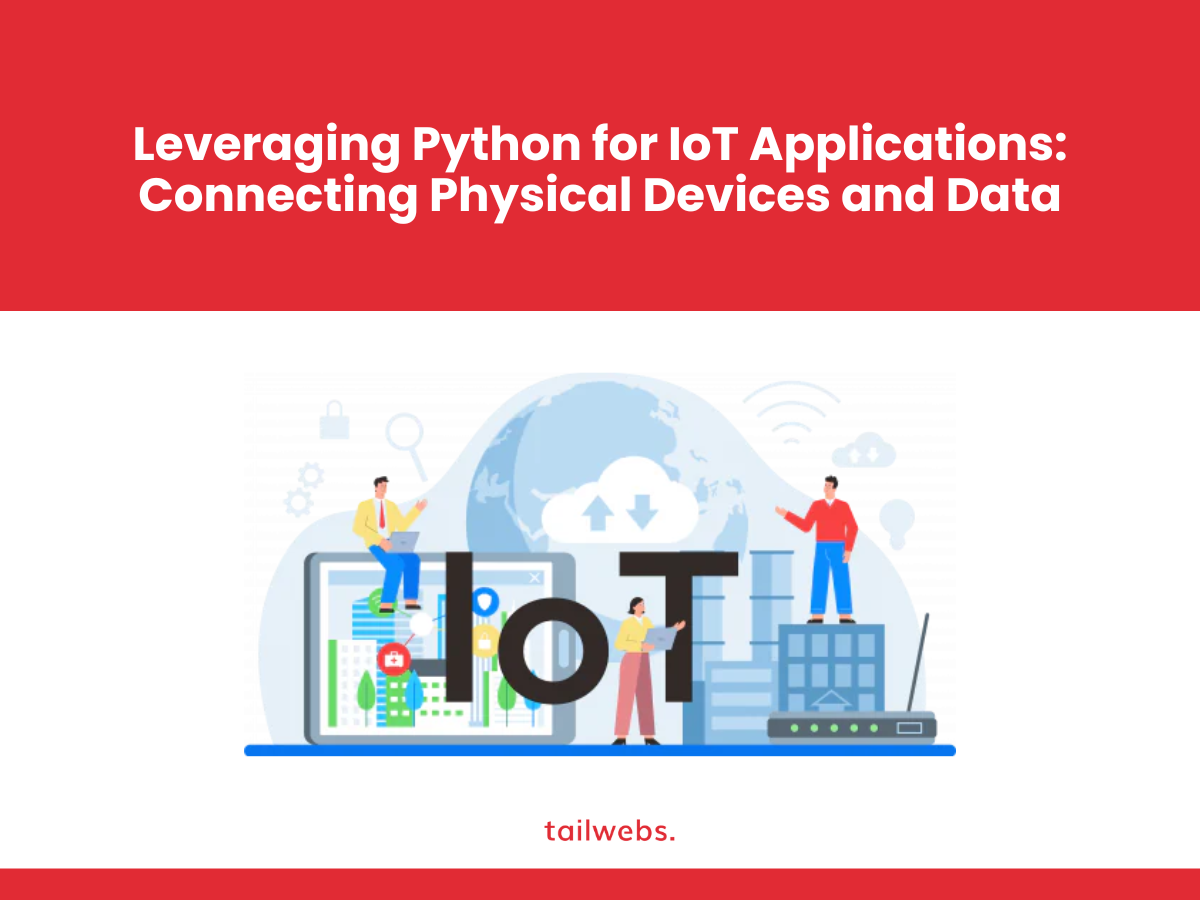The Internet of Things (IoT) is revolutionizing the way we interact with the world around us. From smart homes and wearables to industrial automation and connected cities, IoT devices are transforming how we collect data, monitor systems, and control physical objects remotely. Python, a versatile and popular programming language, plays a crucial role in bridging the gap between the physical world and the digital realm within IoT applications.
This comprehensive guide explores the advantages of using Python for IoT development, delves into core functionalities for building IoT applications with Python, and provides practical examples to showcase its capabilities.
Why Use Python for IoT Development?
Here are some compelling reasons to choose Python for your next IoT project:
Readability & Ease of Learning:
Python’s syntax is known for its simplicity and clarity, making it an excellent choice for beginners and experienced developers alike. This translates to faster development cycles and easier collaboration within teams.
Extensive Libraries & Frameworks:
The Python ecosystem boasts a rich collection of libraries and frameworks specifically designed for IoT development. Popular options like Raspberry Pi GPIO, PubNub, and paho-mqtt simplify common IoT tasks like sensor data acquisition, communication protocols, and cloud integration.
Versatility:
Python extends beyond core IoT functionalities. You can leverage Python for data analysis (NumPy, pandas), machine learning (Scikit-learn, TensorFlow), and web development (Django, Flask), potentially integrating these functionalities with your IoT application for enhanced capabilities.
Large & Active Community:
Python benefits from a vast and active developer community. This translates into abundant online resources, tutorials, and forums to support you throughout the development process.
Core Functionalities for Building IoT Applications with Python
Here’s a breakdown of essential functionalities for Python-based IoT applications:
Sensor Data Acquisition:
Utilize Python libraries to interact with various sensors and collect data. Examples include libraries like smbus for I2C communication or dht11-sensor for temperature and humidity sensors.
Data Processing & Analytics:
Once data is collected, leverage Python’s data analysis libraries like NumPy and pandas to clean, manipulate, and analyze sensor data. You can extract meaningful insights and identify patterns for informed decision-making.
Communication Protocols:
IoT devices communicate using various protocols like Message Queuing Telemetry Transport (MQTT) or Constrained Application Protocol (CoAP). Python libraries like paho-mqtt or aiocoap simplify communication between your Python application and IoT devices.
Cloud Integration:
Many IoT applications involve sending data to the cloud for storage, visualization, and further analysis. Python offers libraries like boto3 (AWS) or azure-identity (Microsoft Azure) to seamlessly integrate your application with popular cloud platforms.
User Interface (UI) Development:
While some IoT applications may be headless, some might require a user interface for data visualization, configuration, or user interaction. Python frameworks like Tkinter or PyQt can be used to develop basic UIs for your IoT application.

Building an IoT Application with Python: A Practical Example
Let’s explore a practical example of building a simple IoT application with Python to monitor temperature and humidity using a Raspberry Pi and a DHT sensor:
Hardware Setup:
Connect a DHT sensor (e.g., DHT11) to your Raspberry Pi following the sensor’s wiring diagram.
Install Necessary Libraries:
Use pip to install required libraries:
Bash
pip install dht11-sensor RPi.GPIOPython Script for Data Acquisition:
Python
import RPi.GPIO as GPIO
import dht11_sensor
# Define sensor pin and GPIO mode
sensor = dht11_sensor.DHT11(pin=4)
GPIO.setup(sensor.pin, GPIO.IN)
# Read temperature and humidity data
result = sensor.read()
# Check for successful data acquisition
if result.is_valid():
print("Temperature: {}°C Humidity: {}%".format(result.temperature, result.humidity))
else:
print("Failed to read sensor data!")
# Clean up GPIO resources (optional)
GPIO.cleanup()This script demonstrates how to use the dht11-sensor library to interact with the DHT sensor and read temperature and humidity values. You can extend this example to:
- Schedule data collection at regular intervals using libraries like
schedule. - Implement data visualization using libraries like Matplotlib to create real-time temperature and humidity graphs.
- Send sensor data to the cloud for storage and remote monitoring using libraries like
paho-mqtt.
Advanced Functionalities for Python-based IoT Applications
As your IoT projects become more intricate, here are some additional functionalities to consider:
Machine Learning Integration:
Incorporate machine learning algorithms into your Python application to analyze sensor data and extract deeper insights. Anomaly detection, predictive maintenance, and pattern recognition are just a few examples of how machine learning can enhance your IoT application’s capabilities.
Real-Time Data Streaming:
For applications requiring real-time data processing, explore libraries like Kafka or Apache Pulsar to enable continuous data streams from your IoT devices to the cloud for real-time analysis and visualization.
Security & Authentication:
As your IoT application interacts with potentially sensitive data, prioritize robust security measures. Implement secure communication protocols, user authentication mechanisms, and data encryption to safeguard your system from unauthorized access.
Remote Device Management:
Develop functionalities to remotely configure, update, and manage your deployed IoT devices. Python libraries like SSH or Paramiko can be used to establish secure remote connections to your devices.

Security Considerations for Python-based IoT Applications
Securing your IoT application is paramount. Here are some key security considerations:
Secure Coding Practices:
Follow secure coding practices in your Python code to minimize vulnerabilities. This includes input validation, proper error handling, and avoiding common coding pitfalls that could be exploited by attackers.
Authentication & Authorization:
Implement strong authentication and authorization mechanisms to control access to your IoT devices and data. Utilize secure password hashing techniques and restrict access based on user roles and permission levels.
Data Encryption:
Encrypt sensitive data both at rest and in transit. This protects data confidentiality even if attackers gain access to your system or intercept data transmissions.
Network Security:
Secure your network infrastructure to prevent unauthorized access. Utilize firewalls, monitor network traffic for suspicious activity, and keep your operating systems and software up-to-date with the latest security patches.
The Future of Python in IoT Development
The future of Python in IoT development is promising, with several trends shaping the landscape:
Focus on Edge Computing:
Expect to see a growing emphasis on edge computing, where data processing and analysis happen closer to the source of the data (i.e., on the IoT devices themselves). Python libraries like TensorFlow Lite can be used to deploy machine learning models on resource-constrained devices for real-time decision-making at the edge.
Rise of Low-code/No-code Development:
The emergence of low-code/no-code development platforms specifically designed for IoT could potentially make it easier for non-programmers to build basic IoT applications using Python.
Integration with AI and Blockchain:
Expect deeper integration between Python and advancements in AI and blockchain technologies. This will enable the development of even more sophisticated and secure IoT applications with capabilities like autonomous decision-making and tamper-proof data management.

Conclusion: Building the Future of IoT with Python
Python offers a powerful and versatile toolkit for building innovative and secure IoT applications. Its ease of use, rich ecosystem of libraries, and large community make it a compelling choice for developers of all experience levels. As the IoT landscape continues to evolve, Python is well-positioned to remain at the forefront of enabling the next generation of connected devices and intelligent systems. By leveraging Python’s capabilities and staying informed about emerging trends, you can build robust and secure IoT applications that transform the way we interact with the world around us.





